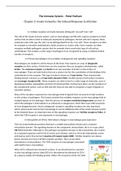The Immune System – Peter Parham
Chapter 3: Innate Immunity: the Induced Response to Infection
3-1 Cellular receptors of innate immunity distinguish ‘non-self’ from ‘self’
The cells of the innate immune system, such as macrophages and NK cells, express receptors on their
surface that are able to bind to molecules expressed by pathogens. Human cells don’t express these
molecules and in this way the ‘self’ can be distinguished from the ‘non-self’. These receptors can bind
for example to microbial carbohydrates, lipids, proteins or nucleic acids. Each receptor can often
recognize multiple pathogenic species that for example share a particular type of cell-surface
carbohydrate. This enables a wide range of pathogens to be recognized by using a relatively limited
number of receptors.
3-2 Tissue macrophages carry a battery of phagocytic and signalling receptors
Macrophages are resident in all the tissues of the body. They express an array of phagocytic
receptors on their surface. Firstly there are the receptors that can recognize carbohydrates, called
lectins. The mannose receptor and dectin-1 are two examples of lectins on the surface of
macrophages. These are both lectins that use a calcium ion for the coordination of the binding of the
carbohydrate to the receptor. This type is lectins is known as C-type lectins. Their characteristic
binding domain is known as a C-type lectin domain (CTLD). Another group of cell surface receptors
are scavenger receptors (SR). These receptors are able to bind to a wide range of molecules, such as
lipopolysaccharides, lipopeptides and CpG rich bacterial DNA. Furthermore there are the receptors of
the complement system, such as CR3 and CR4, that are also able to recognize a range of ligands on
microbial surfaces.
Many of the receptors expressed on macrophages bind to ligands that are present in high numbers
on the surface of pathogens. This feature enables that multiple receptors on the macrophage bind to
multiple ligands on the pathogen. Now the process of receptor-mediated phagocytosis can start, in
which the pathogen is internalized in an endosome or phagosome, which then fuses with lysosomes
to form phagolysosomes. Next to phagocytic receptors, signalling receptors are also expressed
which, when bound, instruct the macrophage to recruit additional cells of the innate immune system
to the infected tissue. An important class of this signalling receptors are Toll-like receptors (TLRs), of
which the TLR4 receptor is one expressed on macrophages.
3-3 Recognition of LPS by TLR4 induces changes in macrophage gene expression
TLRs are transmembrane proteins that have a variable extracellular domain and a constant
intracellular domain. The signalling domain on the cytoplasmic (intracellular) site is of a type called
TIR (Toll Interleukin-1 Receptor). The pathogen recognition domain on the extracellular site consists
of a repeated sequence motif of 20-29 amino acid residues, which is rich in the hydrophobic amino
acid leucine and is thus termed a leucine-rich repeat region (LRR). Toll-like receptors are always
dimers formed out of two Toll-like receptors proteins. They can be either
homodimers or heterodimers. The TLR4 receptor on macrophages associated
with itself to form a homodimer.
When LPS is released from bacterial surfaces, it can directly bind to a protein
on the macrophage surface called CD14 or alternatively be delivered to CD14
by a plasma soluble LPS-binding protein. When LPS is bound to CD14, the TLR4
, dimer associates with a protein called MD2 and together they form a complex with CD14 and LPS.
The TIR domain on the cytoplasmic site of the TLR4 now changes conformation such that it can bind
to the TIR domain of the adapter protein MyD88. The second domain of MyD88 now binds to a
protein kinase called IRAK4, which phosphorylates itself and dissociates from the complex. IRAK4
phosphorylates another adaptor protein called TRAF6. Additional steps eventually lead to the
activation of a kinase complex called the inhibitor of κB kinase (IKK). The function of IKK is to activate
the transcription factor nuclear factor κB (NFκB). This transcription factor is held in the cytoplasm in
an inactive complex with the inhibitor of κB (IκB). IKK phosphorylates IκB so that NFκB is released
from inhibition and can initiate transcription of genes for cytokines, adhesion molecules and other
inflammation related proteins.
3-4 Activation of resident macrophages induces a state of inflammation at sites of infection
Cytokines are small soluble proteins used as a means of communication between cells. When an
infection has been detected in a tissue, the resident macrophages become activated to recruit other
cells to the infected tissue by secreting several cytokines. Five prominent cytokines secreted are:
interleukin-1β (IL-1β), interleukin-6 (IL-6), interleukin-12 (IL-12), CXCL8, and tumor necrosis factor-α
(TNF-α). Collectively, these cytokines are called inflammatory cytokines, because their effect is to
create a state of inflammation in the infected tissue. Inflammation causes the infected tissue to swell
and become red, painful and hot. In a normal state, cells of the immune system are not able to
migrate to healthy tissue. A major task of cytokines is to reverse this situation. The cytokines IL-1β
and TNF-α cause the dilation of blood vessels, which makes them more permeable, allowing effector
cells (white blood cells) and fluid to enter the inflamed tissue. CXCL8 is a chemoattractant cytokine,
or chemokine, which attracts neutrophils away from the blood and toward the infected area where
macrophages are secreting inflammatory cytokines. IL-12 induces NK cells to proliferate and secrete
cytokines that sustain macrophage activation. Monocytes are recruited from the blood and matured
into macrophages by IL-12. A major task of these macrophages is the phagocytosis of neutrophils
that died in the inflamed tissue. Lastly the cytokine IL-6 is responsible for the increase in temperature
in the inflamed tissue, by increasing the metabolism of local muscle and fat cells.
3-5 NOD-like receptors recognize bacterial degradation products in the cytoplasm






